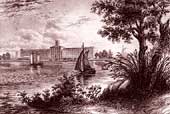The Penitentiary Reigns & Conditions Deteriorate
The Penitentiary is fast becoming the primary punishment. Large and grand in design, both inside and out, these institutions are the pride of America, and they are built everywhere. For practical reasons, the Auburn prison system, which incorporates congregate work, becomes the prevailing model. Strict discipline, routine, hard labor, separation, constant surveillance, silence, and religion are supposedly foolproof means to repentance and deterrence. Though believed to be far more humanitarian than earlier punishments, imprisonment is hardly a pleasant way to spend time. Corporal punishments, from whippings to gags, are often employed, and the silence inside the walls is deafening. The regimentation and constant gaze affected inmates on a deeper level than the pillory ever could.
By the 1850s prisons are overcrowded, mismanaged, and underfunded; discipline is growing more brutal and severe. Sentences are extremely long, and inmates who are let out are likely to return. Reformers are quick to document the problems plaguing penitentiaries, and commissions are formed to examine the institutions. Virtually all of the original goals, such as maintaining silence and separation, prove impossible in this deteriorating atmosphere. Philosophy gives way to practical concerns, and by the 1870s prisons can just manage to focus on custody and the warehousing of inmates. Reformation and deterrence are all but forgotten.
 |
| Blackwell's Island
Anonymous, 1853 |